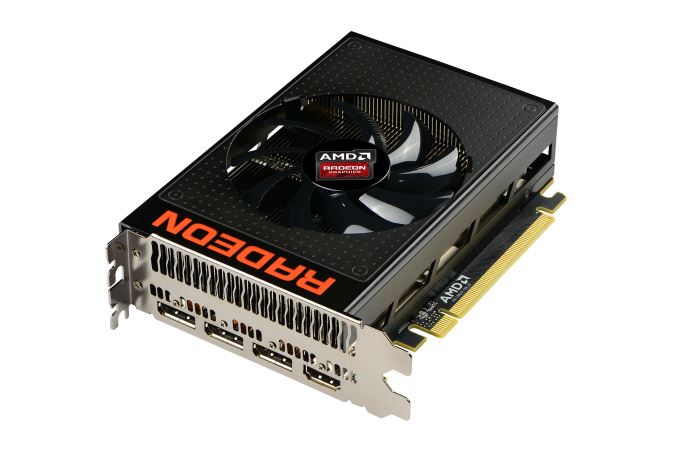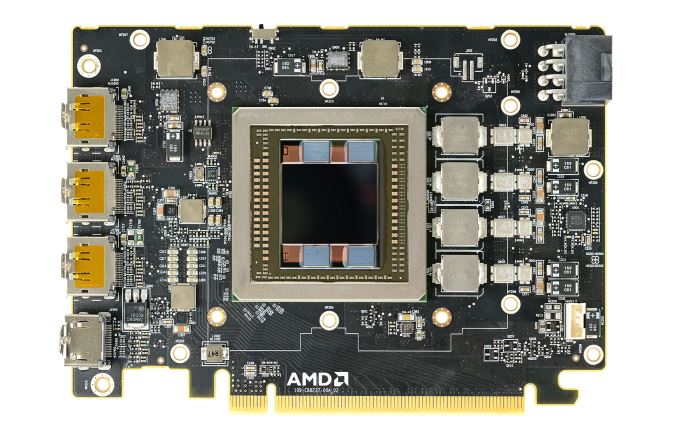The AMD Radeon R9 Nano Review: The Power of Size
by Ryan Smith on September 10, 2015 8:00 AM ESTFinal Words
Of all of the Fiji-based cards we’ve looked at so far, I feel like the Radeon R9 Nano is the most interesting of them. It’s not the fastest card or the cheapest card, but I like that AMD is trying unconventional things. A product like the R9 Nano will never be a high volume product, but it’s the kind of outside the box thinking AMD needs to do in order to better differentiate themselves from NVIDIA and to escape their increasingly damaging reputation as the value alternative underdog.
To that end there’s a lot to like about the R9 Nano, though it admittedly defies standard categorization at times. By all practical metrics this is a luxury card in the same vein as NVIDIA’s GTX Titan series, but at the same time it’s not a card built for chart-topping performance. Rather it’s a card built to push the envelope on power and space efficiency. This makes AMD’s job to sell the card to the public both harder and easier, though not always for obvious reasons.
Starting with the highlights then, let’s talk about the size. As far as Mini-ITX cards go the R9 Nano is a card without an equal. It is the fastest Mini-ITX card on the market and comfortably so, thanks to the fact that all other cards in this space are based on lower performing parts such as the GeForce GTX 970 and Radeon R9 380. Producing a small card is a solid, practical application of the Fiji package and the space savings of HBM, allowing AMD to produce a card just 6 inches (152mm) long. If you need the fastest thing that fits into 170mm or less – and you don’t mind paying top dollar for it – then the R9 Nano has earned its place right there.
Meanwhile when it comes to energy efficiency, the R9 Nano also marks a new high point for AMD. To cut right to the chase, AMD has struggled on the subject of energy efficiency for some time now, particularly since NVIDIA launched their Maxwell 1 and Maxwell 2 architectures last year. The release of the R9 Nano represents a significant improvement for AMD, showing us what an energy efficient implementation of Fiji is capable of.
Relative to the other Fiji cards – the Radeon R9 Fury series – AMD has been able to significantly cut their power consumption in exchange for a limited performance regression. At 2560x1440 – what I expect will be the gaming sweet spot for the R9 Nano – the card delivers 90% of the R9 Fury X’s performance and 96% of the R9 Fury’s performance. Though a tangible decrease in performance, it comes with 35% and 20% decrease in power consumption respectively, allowing AMD to offer better performance-per-watt than any other Radeon product to date.
Now there is a catch here, and that these efficiency improvements come from chip binning and a careful crafting of the product specifications, and not from an architectural improvement. On the whole Fiji still needs to draw quite a bit of power to achieve its peak performance and R9 Nano doesn’t change this. Instead with R9 Nano AMD makes a deliberate and smart trade-off to back off on GPU clockspeeds to save significant amounts of power. The last 100MHz of any chip is going to be the most expensive from a power standpoint, and as we’ve seen this is clearly the case for Fiji as well.
Otherwise on a broader competitive basis, while AMD is enjoying an improvement in energy efficiency they still must contend with NVIDIA, and here is where things get murky. Relative to the rest of their lineup the R9 Nano’s energy efficiency is fantastic. However relative to the energy efficiency of NVIDIA’s lineup, AMD’s gains mostly serve to close the gap that already existed. While admittedly only painting the broadest of strokes here, R9 Nano demonstrates slightly better performance than GTX 980 –around 5% at 2560x1440 – for a similar increase in power consumption. Which is to say that AMD has closed the gap, but they don’t have any real lead.
As a result the answer to the question “is there a market for energy efficient cards within the desktop space?” is going to hinge on price, and that puts AMD in a rough spot given the R9 Nano’s status as a luxury card. Clearly there’s a market for such cards – NVIDIA has spent the last year doing just that – but price is clearly a factor as well. Luxury products typically offer something that no other product offers, and while AMD’s energy efficiency has improved here, they aren’t offering a level of efficiency NVIDIA wasn’t already offering. And that as a result makes AMD’s task all the harder; they can’t pitch energy efficiency as a luxury element if NVIDIA already offers it.
In the end then the R9 Nano is a mixed bag for potential buyers. Its $650 price tag is without a doubt steep compared to the R9 Fury X and GTX 980 Ti, but in its niche of Mini-ITX cards it’s the card to beat, and that will give AMD the room they need to charge that price. On the other hand as great as R9 Nano’s power consumption and energy efficiency are, unless you also need the small size it doesn’t do enough to set itself apart from cheaper products like the GTX 980.
Finally, turning our eyes towards the future, there is one final Fiji product launch on AMD’s 2015 roadmap, and that is the unnamed dual Fiji card. By launching the R9 Nano first, AMD has primed the pump to potentially take their dual-GPU card in one of two different directions. They could essentially combine a pair of R9 Fury Xs and go for a maximum power, maximum performance card similar to the Radeon R9 295X2. On the other hand if they were to combine a pair of R9 Nanos they could produce a slightly slower but much more power efficient card. Both configurations have their virtues and weaknesses – energy efficiency versus absolute performance – so it should be interesting to see which of these two routes AMD takes later this year.












284 Comments
View All Comments
SeanJ76 - Thursday, September 10, 2015 - link
AMD is about to claim bankruptcy......silverblue - Friday, September 11, 2015 - link
Somebody just bought 20% of their shares. If you want them to file chapter 11, be a little more patient, grasshopper.close - Thursday, September 10, 2015 - link
Guess Nvidia is dead to you as a brand also for the whole 3.5GB issue (which we all know how well was handled). That leaves you with the Intel iGPU. But some people have the little fetish of being crapped on from a single direction.Saying "they're dead to me as a brand" is the same as saying "from now on I will disconsider their offerings even if they may be better value or simply better". And this does you no favors, trust me.
Azix - Thursday, September 10, 2015 - link
Does AMD not give out review guidelines? It seems that's something nvidia does. eg when the Ashes benchmark came out they told review sites not to use AA, a lot didn't. Maybe AMD figures some sites will ignore this guidance. eg. if they said nano was not to be compared to the 980ti or fury X and was a niche product for small cases, some sites like kitguru would still compare it to a 980ti rather than the closest mini GPUgw74 - Thursday, September 10, 2015 - link
It is none of the companies' business how their products are reviewed. Their only business to make good products. Anyone can compare anything they like to anything else and benchmark it using anything they want.ianmills - Thursday, September 10, 2015 - link
I wish it was but even anandtech falls in line with this and overuses company's marketing terms to make it hard to compare to previous generationsRyan Smith - Thursday, September 10, 2015 - link
Interesting. I'm certainly not trying to "fall in line" or otherwise use specific marketing terms, so if I'm doing that then it's unplanned. What terms have I been using, so that I can watch out for it in the future?Alexvrb - Friday, September 11, 2015 - link
Yeah! Tell em gw! Same with automotive testing. No guidelines, no rules! If they loan you a 1-ton pickup truck and you compare it to sports cars on a twisty track, bash the truck and give it a horrible review for "poor handling vs 500K exotic sports cars" - well that's none of their business!/sarcasm
gw74 - Sunday, September 13, 2015 - link
I am talking about no guidelines or rules from the manufacturers, genius. That obviously does not mean the reviewing party does not use its brain to compare and test in a sensible way. You absolute clown.Kutark - Thursday, September 10, 2015 - link
They're not demands, they're just telling people ahead of time if there is a particular game that is exhibiting issues with a particular setting. Which especially if its an in progress issue they're debugging, doesn't paint a good picture of the product, and only serves to give ammunition for detractors to cherry pick data points to use in their crusades.